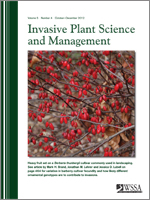The effects of annual, aerial and ground, herbicide treatments with glyphosate and metsulfuron were evaluated for control of Old World climbing fern (OWCF) and effects on native plants on tree islands in Arthur R. Marshall Loxahatchee National Wildlife Refuge during 2006 to 2009. Initial aerial herbicide treatments reduced OWCF cover by greater than 98% on metsulfuron-treated islands and greater than 88% on glyphosate-treated islands, but there was a concomitant decrease in native ground cover with both herbicides. Follow-up ground treatments, during years two and three of the study, were effective at maintaining low levels of OWCF. OWCF cover at the end of the study was 1 to 2% of pretreatment cover on metsulfuron-treated islands and 8 to 10% on glyphosate-treated islands. At the end of the study (3 yr after treatment), species richness was dominated by ruderal native species not typically found on tree islands. The survival rate of tree and shrubs was 65 to 93% on islands treated with metsulfuron and 6 to 20% on islands treated with glyphosate. Minimum effects were recorded for canopy cover on tree islands treated with metsulfuron compared with glyphosate. These data indicate that the aerial application of metsulfuron can be used for control of OWCF on tree islands. Follow-up ground treatments will be required for OWCF regrowth and new sporelings and should be conducted within 1 yr of the aerial application.
Nomenclature: Glyphosate, metsulfuron, Old World climbing fern, Lygodium microphyllum (Cav.) R. Br
Management Implications: The use of herbicides can effectively control Old World Climbing Fern (OWCF) on Everglade tree islands but results in substantial nontarget damage to ground cover. Aerial applications of metsulfuron limited shrub and tree mortality and reductions in canopy cover compared with glyphosate treatments. Monitoring and follow-up treatments on an annual basis would be required for control of OWCF. Without herbicide management, OWCF will continue to form monocultures on tree islands and other habitats resulting in lower native-species richness, evenness, and canopy cover. Follow-up treatments will reduce OWCF growth and spore production, limiting the ability of OWCF to infest new sites from wind blown spores. It is likely that OWCF cover can return to pretreatment levels less than 6 yr following a single herbicide treatment. The best management strategy for OWCF on tree islands is an initial aerial application with metsulfuron over large infestations and annual monitoring and follow-up ground treatments as needed. Managers using aerial application of herbicides for control of OWCF can expect to observe shifts from late-successional vegetation, typical of tree islands, to ruderal species, typical of disturbed sites.





